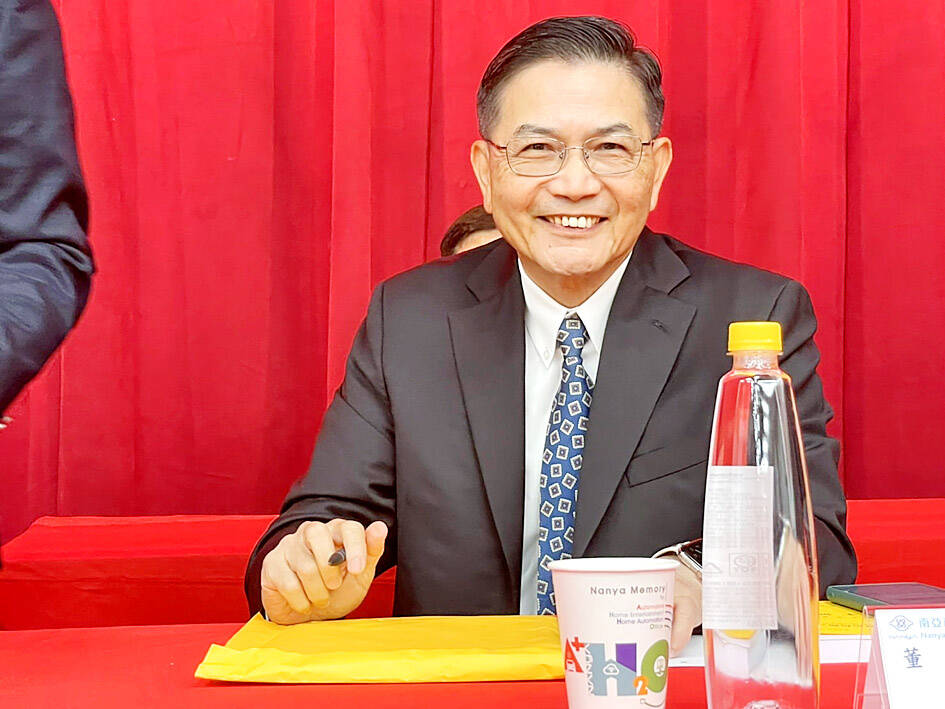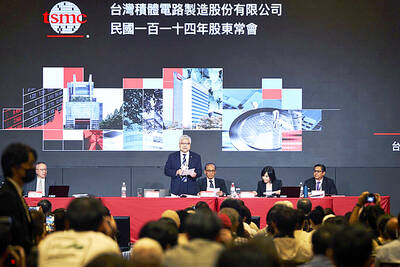Nanya Technology Corp’s (南亞科技) chances of returning to the black next quarter are increasing due to improving supply-demand dynamics as the world’s top three memorychip makers allocate more capacity for the production of high-bandwidth memory (HBM) chips, the company said yesterday.
Such a capacity shift plays a major role in bringing down inventory and propping up DRAM chip prices, as pressure for standard DDR4 supply weakened, Nanya Technology president Lee Pei-ing (李培瑛) said on the sidelines of the company’s annual shareholders’ meeting in Taoyuan.
About 10 percent of the world’s DRAM capacity this year would be used for the production of HBM chips, which are essential to artificial intelligence (AI) applications, Lee said.

Photo: Grace Hung, Taipei Times
HBM chips offer much faster data processing speeds than standard DRAM chips, he said.
To cope with strong AI demand, DRAM chipmakers would continue to allocate more capacity, originally reserved for DDR4 chips, for the production of high-density DDR5 chips, Lee said.
That capacity shift is highly likely to accelerate next year, riding on the AI boom, he said.
“We are anticipating a further improvement in the global [DRAM] market in the second half. Prices will also improve quarter by quarter,” Lee said.
For Nanya Technology, that increases the likelihood that it would swing back to profit, Lee said.
The company has dipped into the red for the past six quarters.
In addition to improving supply-demand dynamics, the introduction of new smartphones and PCs featuring AI functions would boost demand for DRAM chips, Nanya Technology chairman Wu Chia-chau (吳嘉昭) told shareholders.
A recovery in consumer electronics, such as televisions ahead of the Paris Olympics and the new Wi-Fi 7 standard would also drive DRAM demand, Wu said.
The company expects its gross margin to return to positive territory this quarter from minus-2.9 percent in the previous quarter.
DDR4 chips account for more than 60 percent of the company’s total shipments, and Nanya Technology expects to start small-volume production of its first DDR5 chips in the second half of this year, Lee said, adding that the more advanced DDR5 chips would be used in PCs and servers.
The company aims to supply high-density DDR5 modules in the second half of next year, based on its through-silicon via technology, it said.
Regarding the HBM market, the company would not rush into this highly competitive market as it would need a long-term plan and comprehensive preparations, Lee said.
Nanya Technology did not comment on local media reports that it has formed an HBM task force to facilitate the technology’s advancement.

CAUTIOUS RECOVERY: While the manufacturing sector returned to growth amid the US-China trade truce, firms remain wary as uncertainty clouds the outlook, the CIER said The local manufacturing sector returned to expansion last month, as the official purchasing managers’ index (PMI) rose 2.1 points to 51.0, driven by a temporary easing in US-China trade tensions, the Chung-Hua Institution for Economic Research (CIER, 中華經濟研究院) said yesterday. The PMI gauges the health of the manufacturing industry, with readings above 50 indicating expansion and those below 50 signaling contraction. “Firms are not as pessimistic as they were in April, but they remain far from optimistic,” CIER president Lien Hsien-ming (連賢明) said at a news conference. The full impact of US tariff decisions is unlikely to become clear until later this month

With an approval rating of just two percent, Peruvian President Dina Boluarte might be the world’s most unpopular leader, according to pollsters. Protests greeted her rise to power 29 months ago, and have marked her entire term — joined by assorted scandals, investigations, controversies and a surge in gang violence. The 63-year-old is the target of a dozen probes, including for her alleged failure to declare gifts of luxury jewels and watches, a scandal inevitably dubbed “Rolexgate.” She is also under the microscope for a two-week undeclared absence for nose surgery — which she insists was medical, not cosmetic — and is

GROWING CONCERN: Some senior Trump administration officials opposed the UAE expansion over fears that another TSMC project could jeopardize its US investment Taiwan Semiconductor Manufacturing Co (TSMC, 台積電) is evaluating building an advanced production facility in the United Arab Emirates (UAE) and has discussed the possibility with officials in US President Donald Trump’s administration, people familiar with the matter said, in a potentially major bet on the Middle East that would only come to fruition with Washington’s approval. The company has had multiple meetings in the past few months with US Special Envoy to the Middle East Steve Witkoff and officials from MGX, an influential investment vehicle overseen by the UAE president’s brother, the people said. The conversations are a continuation of talks that

CHIP DUTIES: TSMC said it voiced its concerns to Washington about tariffs, telling the US commerce department that it wants ‘fair treatment’ to protect its competitiveness Taiwan Semiconductor Manufacturing Co (TSMC, 台積電) yesterday reiterated robust business prospects for this year as strong artificial intelligence (AI) chip demand from Nvidia Corp and other customers would absorb the impacts of US tariffs. “The impact of tariffs would be indirect, as the custom tax is the importers’ responsibility, not the exporters,” TSMC chairman and chief executive officer C.C. Wei (魏哲家) said at the chipmaker’s annual shareholders’ meeting in Hsinchu City. TSMC’s business could be affected if people become reluctant to buy electronics due to inflated prices, Wei said. In addition, the chipmaker has voiced its concern to the US Department of Commerce